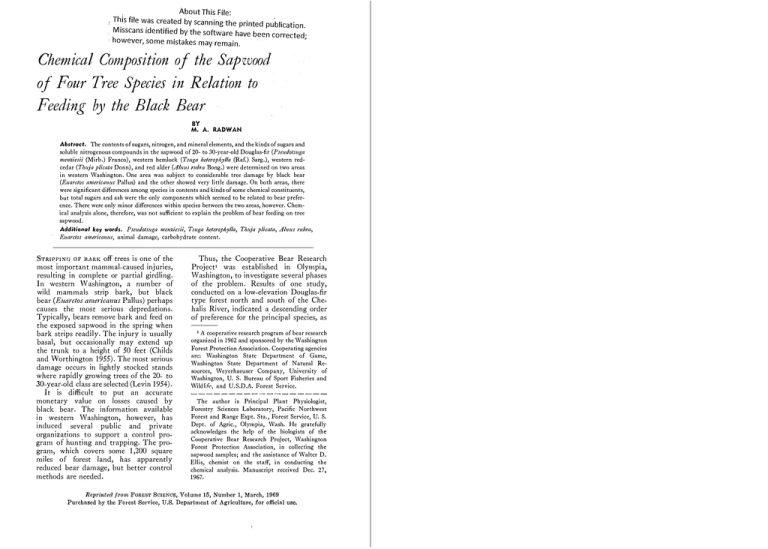About This File: on.
advertisement

About This File: . ; This file was created by scan ning the printed publicat·, on. M'lsscans''dentified by the softwar e have been corrected· however, some mistakes may remain. · ' Chenzical Conzposition of the Sapwood of Four Tree Species in Relation to Feeding by the Black Bear BY M. A. RADWAN Abstract, The contents of sugars, nitrogen, and mineral elements, and the kinds of sugars and soluble nitrogenous compounds in the sapwood of 20- to 30-year-old Douglas-fir (Pseudotsuga menziesii (Mirb.) Franco), western hemlock (Tsuga heteropl1ylla (Raf.) Sarg.), western red­ cedar (Tl111ja plica/a Donn), and red alder (AI11us mbra Bong.) were determined on two areas in western Washington. One area was subject to considerable tree damage hy black bear (Euarctos americanus Pall us) and the other showed very little damage. On both areas, there were significant differences among species in contents and kinds of some chemical constituents, but total sugars and ash were the only components which seemed to be related to bear prefer­ ence. There were only minor differences within species between the two areas, however. Chem­ ical analysis alone, therefore, was not sufficient to explain the problem of bear feeding on tree sapwood. Additional key words. Pseudotsuga menziesii, Tsuga heterop11ylla, Tlutja plicata, Alnus rubra, Euarctos americanus, animal damage, carbohydrate content. STRIPPING OF BARK off trees is one of the most important mammal-caused injuries, resulting in complete or partial girdling. In western W'ashington, a number of wild mammals strip bark, but black bear (Euarctos american us Pallus) perhaps causes the most serious depredations. Typically, bears remove bark and feed on the exposed sapwood in the spring when bark strips readily. The injury is usually basal, but occasionally may extend up the trunk to a height of 50 feet (Childs and Worthington 1955). The most serious damage occurs in lightly stocked stands where rapidly growing trees of the 20- to 30-year-old class are selected (Levin 1954). It is difficult to put an accurate monetary value on losses caused by black bear. The information available in western 'Vashington, however, has induced several public and private organizations to support a control pro­ gram of hunting and trapping. The pro­ gram, which covers some 1,200 square miles of forest land, has apparently reduced bear damage, but better control methods are needed. Thus, the Cooperative Bear Research Project1 was established in Olympia, 'Vashington, to investigate several phases of the problem. Results of one study, conducted on a low-elevation Douglas-fir type forest north and south of the Che­ halis River, indicated a descending order of preference for the principal species, as 1 A cooperative research program of bear research organized in 1962 and sponsored by the Washington Forest Protection Association. Cooperating agencies arc: Washington State Department of Game, Washington State Department of Natural Re­ sources, Weyerhaeuser Company, University of Washington, U. S. Bureau of Sport Fisheries and WildJif.,, and U.S.D.A. Forest Service. The author is Principal Plant Physiologist, . Forestry Sciences Laboratory, Pacific Northwest Forest and Range Expt. Sta., Forest Service, U. S. Dept. of Agric., Olympia, Wash. He gratefully acknowledges the help of the biologists of the Cooperative Bear Research Project, Washington Forest Protection Association, in collecting the sapwood samples; and the assistance of Walter D. Ellis, chemist on the staff, in conducting the chemical analysis. Manuscript received Dec. 27, 1967. Reprinted from FOREST SciENCE, Volume 15, Number 1, March, 1969 Purchased by the FOl'est Se1·vice, U.S. Department of Agriculture, for official use. follows: Douglas-hr (Pseudotsuga men­ ziesii (Mirb.) Franco), western hemlock (Tsuga heterophylla (Raf.) Sarg.), western redcedar (Thuja plicata Donn), and red alder (Alnus rubra Bong.).2 Of the many tree characteristics that may have in­ fluenced this preference, chemical compo­ sition of the sapwood in the spring seemed a major factor. This paper, therefore, reports chemical analyses of sapwood tissue collected in May from the above four species gwwing on two areas, with and without bear damage. The Study Areas The two areas studied had been selected earlier by the Cooperative Bear Research Project. Both are located in Grays Harbor County, Washington; one north of the Chehalis River valley where considerable bear damage occurs, and the other south of the valley where very little damage has been reported, although bears are present. Together, the two areas encompass ap­ proximately 180 square miles. Materials and Methods Sapwood of Douglas-fir, western hemlock, western redcedar, and red alder trees from each of the two areas served as test material. Only healthy trees of the 20- to 30-year-old class and approximately 10 to 12 inches dbh were used. Tissue Sampling. Two composite sapwood samples, of approximately 400 g each, were taken during the morning hours in �May 1965 from each of the four species on both areas. Each sample was taken from 10 trees selected from approximately 5 acres of similar elevation, aspect, soil series, and vegetation composition. In each case, the bark was removed and 0.2- to 0.4-cm-deep samples were cut out with a stainless steel knife. These depths approximated those found on 2 Pierson, Douglas J. Black bear study; black bear-forest rei ationships. Washington State Game Dept. Proj. W71-R-2, job completion rep., 13 pp., mimeo., 1965. 12 / Forest Science bear-damaged trees on the study areas. Sample Preparation. Each sample was cut into .7\!-inch-square pieces with stain­ less steel scissors and homogenized in a blender with stainless steel blades. Sub­ samples were taken for moisture deter­ mination and fot· analyses of sugars and soluble nitrogenous compounds. The remaining tissue was dried to constant weight, ground to 40 mesh in a Wiley mill, and stored in closed containers at -15° C until analyzed. Sugars and soluble nitrogenous com­ pounds were extracted from the fresh tissue by adding hot alcohol at a final concentration of 80 percent and extracting in Soxhlet for 12 hours. The alcoholic solution was then made to volume with the extracting solvent. For sugar determinations, portions of the extracts were concentrated on a water bath and clarified with lead acetate. Additional portions of the extracts were partitioned between water and chloroform to remove the lipids and chlorophyll. Aqueous phases were then evaporated to dryness with warm air jets and residues dissolved in 1-ml amounts of distilled water. Resulting extracts were used for separation of sugars and soluble nitrogenous com­ pounds by paper chromatography. Analytical Methods. Moisture was de­ termined in a forced-air oven at 65° C, and total nitrogen (N) was measured in a Coleman Model 29 analyzer. Ground tissue was ashed in platinum crucibles at 500-550° C, and the ash was analyzed for phosphorus (P) by the colori­ metric method of Fiske and Subbarow (1925), calcium (Ca) by a titrimetric technique (Horwitz 1960), and mag­ nesium (Mg), iron (Fe), and manganese (Mn) by the magnesium ammonium phosphate titrimetric method, 0-phen­ anthroline colorimetric method, and the colorimetric periodate procedure, re spectively (Chapman and Pratt 1961). Results Sugar was determined in the clarified tissue extracts before and after hydroly­ sis by Hassid's eerie sulfate method (1937). Reducing and total sugars were calculated as glucose and nonreducing sugars as sucrose. Concentrations of the chemical constitu­ ents of sapwood, summarized in Table 1, are expressed on a fresh-weight basis to allow comparison of levels as the animal encounters them in feeding. Sugars and soluble nitrogenous com­ pounds were separated by two-dimen­ sional chromatography on 'Vhatman No. 1 paper. The paper was developed in the short direction with liquid phenol: water (4: 1 V/V) with 0.04-percent 8­ hydroxyquinoline, and then in the long direction with the upper phase of n­ butanol: acetic acid: water (25:6:25 V/ V/V) (Block et a/. 1958). Sugars and soluble nitrogenous compounds, respec­ tively, were located on separate chro­ matograms with aniline-diphenylamine­ phosphate (Block et a/. 1958) and 1.0 percent ninhydrin (Thompson et a/. 1951) color reagents. Identity of resultant spots was then made from their RF values and by co-chromatography with authentic compounds. Moisture. There were only slight vari­ ations in moisture content among species and none within species from the two study areas (Table 1). The average moisture content for all samples was approximately 90 percent, indicating a low dry matter content of about 10 percent. dslz. The ash content was lowest in Douglas-fir, intermediate in hemlock, and highest in redcedar and red alder (Table 1). Here again, there were no differences between the species from the two areas. Mineral elements in the sapwood, as shown by the ash content, were low. They averaged less than 1 percent on a fresh­ weight basis, and about 7 percent wh;;"n TABLE 1. Concentration of selected chemical constituents in the fresh sapwood of four tree species in tl1e spring.' Species and collection area2 Moisture Ash Reduc- Nonreing clueing Total sugars sugars sugars N p Mn Ca Mg . 013a . 015a . 010ab .00027a ,00065a . Ollah . 00031a .00060a Fe Percmt offresh weight Douglas-fir Damage .43a 89.2a3 90.2ah .43a !\Tondamage Western hemlock .65b 89.2a Damage .64b 89.1a Nondamage Western redcedar 91.4b .83c Damage 91.4b .SSe Nondamage Red alder 91.3b 1 .02c Damage 90.6ab .91c Nondamage 3.63a 3. 75a .64a 4.30a .58a 4.36a . 13a .12a 1.97c 1.62c 3.67a .13a 1. 76c 1.96c 3.83a .13a .034a . 031a .033a .021h . 013cb .035a .029h . 015c .00042a .0021 b . 00044a .0019 b . 00027c . 00018c .SOh 1.63c 2 . 69h . 65b 1.93c 2. 69b . 13a .032a . 13a .028a . 025h .009a . 022h .009a . 00042a .00045a .50a 2.10c .43a 1.80c .17h .035a .22c .030a .025b .040b . 025b .032e .0012 b . 00079a .0012 b . 00074a 1.56c 1 . 45c 1 Values are averages of two composite samples from 10 trees each. 2 Damage and nondamage areas are, respectively, north and south of the Chehalis River. 3 Means in each column followed by the same letter(s) do not differ significantly at the 5-percent level, with a modification of Tukey's test (Snedecor 1961). volume 15, number 1, 1969 / 13. expressed on a dry-weight basis This indicates that an average of approxi­ mately 93 percent of the dry n)atter was organic in nature. Sugars. Concentrations of reducing, non­ reducing, and total sugars differed sig­ nificantly among species. Within species, however, sapwood from the two areas contained similar amounts of the sugars. Total sugar content was highest in Douglas-fir and to a lesser extent in hemlock, medium in redcedar, and lowest in red alder. The concentration range of the sugars, calculated on a fresh-weight basis, was 1.80 to 4.36 percent (Table 1). However, calculation to an organic­ matter basis shows that the average concentrations of total sugars were 43, 37, 33, and 24 percent in Douglas-fir, hemlock, redcedar, and red alder, re­ spectively. Sugars, therefor , were one of the major organic constituents of the sapwood. Contributions of reducing and nonre­ ducing sugars to the total sugar content varied among species. The simpler re­ ducing sugars predominated in Douglas-fir and, to a lesser extent, in red alder. In contrast, the more complex nonreducing sugars contributed approximately 50 per­ cent of the total sugars in hemlock and prevailed over reducing sugars in red­ cedar. Three sugars were detected chromato­ graphically: glucose, fructose, and sucrose. In addition, visual examination of the chromatograms showed that in all ex­ tracts, concentrations of glucose and fructose were approximately equal. All sapwood samples, therefore, contained the same kinds of sugar and glucose/ fructose ratio. Nitrogen. Total N content in sapwood ranged from 0.12 to 0.22 percent, indi­ cating a low level of this element in the tissue. Regardless of the area, Douglas­ fir, hemlock, and redcedar contained similar amounts of the element. In con­ 14 / FQT'est Science trast, red alder from the nondamage area was higher in N than that from the damage area. Also, the average N con­ tent for red alder sapwood of both areas at 0.20 percent was significantly higher than that in sapwood of the other three species. vVithin species, nitrogenous compounds detected by chromatography did not differ with area of collection. However, amounts and, to a lesser extent, kinds of nitrogenous compounds varied among the species. Alanine, serine, aspartic acid, and 'Y-aminobutyric acid were found in all extracts. Additional nitro­ genous compounds were also found in the extracts as follows: traces of glycine in Douglas-fir and hemlock, traces of gluta­ mine in redcedar, and traces of glutamic acid and large amounts of citrulline in red alder. 'Vith the exception of citrul­ line, which has been reported only in a few plants including alder, the nitrogenous compounds found in sapwood occur widely in plants (Bollard 1957). Jvfineral Elements. Concentrations of some of the mineral elements known to be important in animal nutrition (Maynard 1951) are shown in Table 1. For all samples, the average concentrations of P, Ca, Mg, Fe, and Mn were .032, .022, .017, .00059, and .00090 percent, re­ spectively. With the exception of Mg in red alder, where sapwood from the damage area contained higher concentrations of the element than that from the nondamage area, contents of the individual elements within species did not differ with the area. Among species, there were no differences in the P contents and only a limited number of major differences in contents of the other elements. Thus, Douglas-fir was lowest in Ca, hemlock highest in Mn, redcedar lowest in Mn, and red alder highest in Mg and Fe. Discussion and Conclusions The analysis of sapwood shows that sugar was a major nutrient component of the tissue and mineral elements and nitro­ gen occurred in minor amounts. Also, sapwood tissue w s lower in mineral elements and nitrogen, but higher in sugar than vegetation which serves as bear food on the study areas (unpublished chemical analyses of red whortleberry [Vaccinium parvifolium J. E. Sm.] and salal [Gaultheria shallon Pursh] shoots collected from the same areas and at the same time as tree sapwood). Thus, sap­ wood appeared to be a good source of sugar for bear nutrition. On both areas, there were significant differences among species in contents and kinds of some chemical constituents, but total sugars and ash were the only components which seemed to be related to bear preference. High preference was generally associated with high sugar and low ash. Obviously, it is impossible to state conclusively that one, or a combination of these two components, was actually responsible for the prefer­ ence. However, one may speculate that sugar alone was the important factor. That sugar was apparently a major animal nutrient in sapwood tends to support this speculation. Furthermore, sugar has long been recognized as ex­ tremely important in the nutrition and metabolism of animals (Fruton and Simmonds 1958), and has been suspected to be a factor in food preference of some animals (Plice 1952, Radwan and Camp­ bell 1968). However, the fact that bears do not feed on tree sapwood south of the Chehalis River, despite the similar sugar content and the general chemical compo­ sition of sapwoods on the two study areas, is inconsistent with the sugar hypothesis or any other explanation of preference based on the data from this study. In addition, bears' preference for trees is known to vary by State (Lutz 1951, Glover 1955, Zeedyk 1957) and even by area within western Washington. In this study, therefore, chemical analysis alone was not sufficient to explain the problem of bear feeding on tree sapwood. Attempts by other workers (Fritz 1951, Lauckhart 1956) were also unsuccessful, mainly because of con­ jecture in absence of factual information. Clearly, the problem is influenced by many factors involving both the animal and its habitat. Only by concurrent studies of these factors can bear behavior toward the trees be adequately under­ stood. Literature Cited BLocK, RicHARD J., EMMETT L. DuRRUM, and A manual of paper chroma­ tography and paper electrophoresis. Academic Press, Inc., New York. 710 pp. GuNTER ZwEIG. 1958. BoLLARD , EDWARD G. 1957. Nitrogenous compounds in tree xylem sap. In The Physiology of Forest Trees, pp. 83-93. The Ronald Press Co., New York. CHAPMAN, HoMER D., and PARKER F. PRATT. 1961. Methods of analysis for soils, plants, and waters. Div. Agric. Sci., Univ. Calif. 309 pp. Cmws, THoMAs W., and NoRMAN P. WoRTHING­ TON. 1955. Bear damage to young Douglas-fir. U. S. For. Serv. Pacif. Nthwest. For. Range Expt. Sta. Res. Note 1 13, 3 pp. FISKE, C. H., and Y. SunnAROW. 1925. The colori­ metric determination of phosphorus. J. Bioi. Chern. 66:375-400. FRITZ, EMANUEL. 1951. Bear and squirrel damage to young redwood. J. For. 49:651-652. FRuToN, JosEPH S., and SoPHIA SIMMONDs. 1958. General biochemistry. John Wiley and Sons, Inc., New York. 1077 pp. GLOVER, FRED A. 1955. Black bear damage to red­ wood reproduction. J. \Vildl. Manage. 19:437-443. HAssm, W. Z. 1937. Determination of sugars in plants by oxidation with ferricyanide and eerie sulfate titration. Industr. Engng. Chern., Analyt. Ed. 9:228-229. HoRWITz, WILLIAM (Editor). 1960. Methods of analysis. Assoc. Off. Agric. Chemists, Ed. 9, Washington, D.C. 832 pp. LAucKHART, J. BuRTON. 1956. The effect of logging old-growth timber on bear. Soc. Amer. For. Proc. 1955: 128- 130. R. 1954. The South Olympic Tree Farm. J. For. 52:243-249. LuTZ, H. J. 195 1. Damage to trees by black bears in Alaska. J. For. 49:522-523. MAYNARD, LEONARD A. 1951. Animal nutrition. McGraw-Hill, Inc., New York. 474 pp. PLicE, MAx J. 1952. Sugar versus the intuitive choice of foods by livestock. J. Range Manage. LEVIN, OscAR 5:69-75. volume 15, number 1, 1969 / 15 M. A., and D. L. CAMPBELL. 1968. Snow­ shoe hare preference for spotted catsear flowers in western Washington. J. Wild!. Manage, 32: RADWAN, 104-108. SNEDECOR, GEORGE W. 1961. Statistical methods applied to experiments in agriculture and biology. The Iowa State Univ. Press, Ames. 534 pp. THOMPSON, J. F., R. M. ZAcHARias, and F. C. 16 / Forest Scienre STEWARD. 1951. Investigations on nitrogen compounds and nitrogen metabolism in plants. I. The reaction of nitrogen compounds with ninhydrin on paper: a quantitative procedure. Plant Physiol. 26:375-397. ZEEDYK, WILLIAM D. 1957. Why do bears girdle balsam fir in Maine? J. For. 55:731-732.


